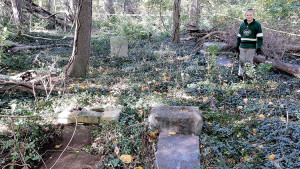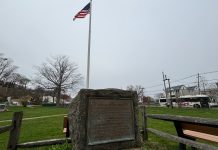LINCROFT – A Monmouth University professor and her students are leading the way to restore long-forgotten 19th century cemetery to a fitting resting place for the African Americans buried there.
What was designed as a social work project for a Monmouth University class is now a county-wide undertaking involving at least two churches, Boy Scouts, Monmouth County Historical Commission representatives, Monmouth County Historical Association, the Middletown Township Landmarks Commission, and dozens of volunteers working to restore a sense of history and pride.
Cedar Hill Cemetery is located off Hurley’s Lane directly behind St. Leo the Great Catholic Church. Once a proud and well cared for final resting place for families who purchased large individual burial plots, it has remained untouched and unnoticed for the most part since it was last tended in the 1940s. Seven decades later, all that could be seen is a large expanse of hilly turf, completely covered with downed trees, brambling bushes, uneven topography, crowded new growth of grass and the damaged, fallen, crushed, and up until now forgotten head and foot stones of those buried there.
Joelle M. Zabotka, PhD, assistant professor at Monmouth University’s School of Social Work, outlined the project which has been in planning and orientation stages for months. The cemetery houses the remains of what could be 100 African American family members, many of whom fought in the Civil War and were families of freed slaves in Monmouth County.
Zabotka heard of the forgotten cemetery through County Historic Commission member Maureen O’Connor Leach and a couple carrying an American flag one Memorial Day, looking for veterans to honor. She determined that a practical lesson for her students would be to discover the identities and lives of those buried there, and the project was launched.

University students visited the site, uncovered many names and birth dates on the stones, and were divided into teams, each assigned to learn more about their subjects. Students were delegated to begin the arduous task of restoring the cemetery.
Adding to the mystery of the project is the actual ownership of the property. Research by historian Joseph A. Grabas, a member of the county historic commission, shows that the plots were sold to individual owners, rather than an entire cemetery tended by a church. In 1958, the Catholic Diocese of Trenton purchased two adjoining chicken farms and built St. Leo the Great’s church, followed by the school, on 20 acres. Since neither burial grounds nor churches pay taxes, the lines separating the properties are unclear as to specific ownership.
Ray Veth, a member of the Middletown Landmarks Commission and the township’s Save Our Cemeteries committee, who has considerable experience in recovering and cleaning up other historic burial grounds in the township, was also on hand Saturday. During the initial work of laying out the original plot plans, determining where the row of trees separating the grounds from adjacent property were located, and helping to identify the people named on the stones, Veth wanted to be certain the project was proceeding within the commission’s guidelines. Later, Veth said, ”This is an outstanding plan. I would not change a thing. It is quite an undertaking, but many hands make light work. Thanks to Dr. Zabotka and all of her efforts in coordinating the cleanup.”
Veth, who also owns a trophy and sign shop in Middletown, offered to donate a sign for the perimeter of the property and said he would work with adjacent property owners to determine the best location. He added he would be happy to help students with their genealogical research and will keep the Middletown Historic Society informed of the progress.
Students have already begun their research, some using the records at the Monmouth County Historical Association, which is also ready to assist in tracing histories through its resources. Some have connected with fourth generation descendants of the deceased, while others have been stymied in their research because of the young age of the deceased and not having any recorded records of land purchases, marriages or progeny.
Grabas spent Saturday morning walking the grounds with Zabotka, comparing the stones they and Boy Scouts from Lincroft Troop 110 uncovered and photographing plots he had from several tax maps drawn at different times in the 20th century. He said each of the plots purchased by individuals and families was large, approximately 100 by 40 feet and more than 100 persons could be buried there. According to an 1850 deed, Grabas said, a property owner named Crawford sold the land as 24 individual plots to a group of African-Americans in the area which was known as Leedsville in the mid-19th century. He presented Zabotka with several maps and help the students with their research.
Grabas noted that records in the Middletown Township Public Library refer to efforts by Judy Norris in 1979 to document the gravestones when the property was known as the Reeves Burial Ground. There are other references to it as Cedar View Cemetery, Lincroft Cemetery, and Hurley’s Woods Burial Ground. Grabas indicated it could also be known as the Alexander Frost Burial Ground, referring to the main proponent of the cemetery who purchased it and sold remaining unsold plots to other individuals or families. Frost also purchased three acres of land from John B. Crawford in 1839.
To add another dimension to the mysteries surrounding the cemetery, Grabas added, “It would be interesting to explore the relationship between Crawford, a former slave owner, and Frost. Was he Crawford’s manumitted slave? Why would a former slave owner convey land to “coloured men”?
The stones themselves, most of them simple granite with names and some life information inscribed, tell the beginnings of stories of the men and women who were most likely former slaves freed during or after the Civil War. Some bear the inscriptions of “Private, USCT CO. B,” which Grabas indicated was the soldier’s rank in the US Colored Troops and his military company during the war. Some give the deceased’s parents, dates of birth and death, and some note the stone was “erected by a friend.” Some of the names of the deceased are not the names of the owners who purchased the plots, Grabas explains, indicating the possibility they were purchased by one person and either donated to or sold to someone else.
Joe Manzi, director of finance and operations for St. Leo’s, was also at the field work Saturday, congratulating Zabotka on the intensity and direction of the project, and indicating the parish’s interest and cooperation in seeing the deceased remembered and their resting places restored.
Zabotka said nearby Calvary Baptist Church has also shown keen interest and suppor t of the project, although no records show that any of the plots were connected with any specific church. Many of the tombstones already uncovered show death dates in the 1870s and 1880s, with the most recent in the early 1900s. At least one of the births, that of Emaline Schanck, is dated 1839, and another, that of John Anthony Holmes, is Dec. 21, 1818. Silas Reeves, a Private in USCT Co B41 Regiment, was born in 1845 and died in 1910.
“This is an exciting project for ever ybody involved,” Zabotka said, “what better way to teach social work than to uncover the lives and histories of people?”
The professor noted that while early work on restoration and renovations is extremely limited until the volunteers and students under her direction can locate and identify every stone in the burying ground, “we will welcome volunteers at some time in the future to help clean the area and restore its appearance as a true burial ground.”














